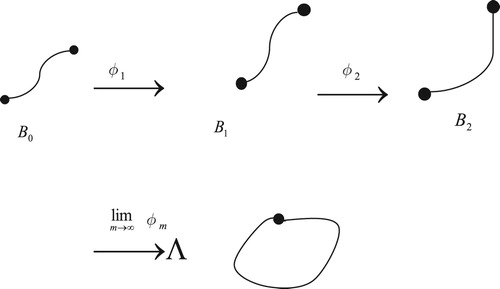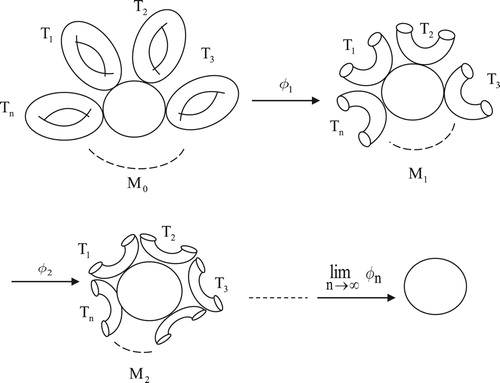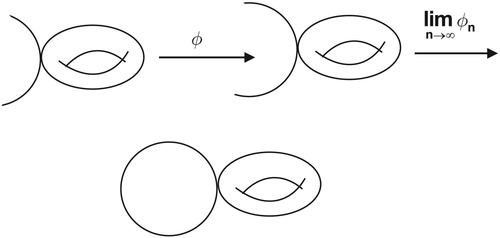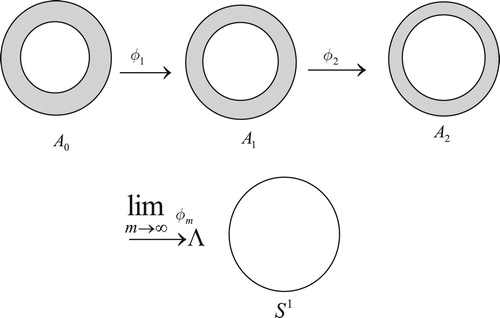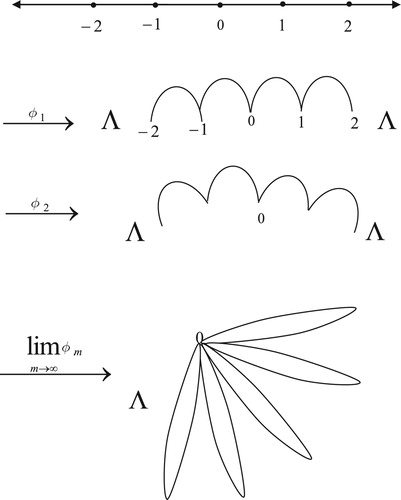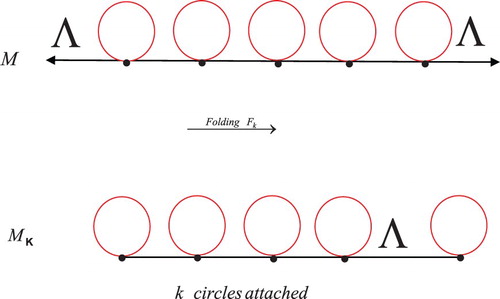 ?Mathematical formulae have been encoded as MathML and are displayed in this HTML version using MathJax in order to improve their display. Uncheck the box to turn MathJax off. This feature requires Javascript. Click on a formula to zoom.
?Mathematical formulae have been encoded as MathML and are displayed in this HTML version using MathJax in order to improve their display. Uncheck the box to turn MathJax off. This feature requires Javascript. Click on a formula to zoom.ABSTRACT
In this paper, the induced sequence of folding and unfolding on the fundamental group will be obtained from a sequence of folding and unfolding on a manifold. The limit of folding and unfolding on the fundamental group is deduced. The sequences of the commutative diagram of fundamental groups will be achieved from the sequences of the commutative diagram of manifolds. The connection between a manifold and a fundamental group is assigned.
KEYWORDS:
1. Introduction and definitions
Classical results in algebraic topology give that groups are naturally realized as fundamental groups of spaces. For instance, free groups arise as fundamental groups of wedges of circles, any group can be realized as the fundamental group of some CW-complex, and pushouts of groups arise via the van Kampen theorem. This ability to construct geometric interpretations of discrete groups has important applications in both topology and algebra. The fundamental group was introduced by Poincare on a topological space that provides a way of determining when two paths, starting and ending at a fixed base point, can be continuously deformed into each other. Intuitively, it records information about the basic shape, or holes, of the topological space [Citation1]. Let be a topological space and
, the set
, together with the product operation
is called the fundamental group where
is a functor map between categories [Citation1]. The fundamental groups of some types of a manifold were studied in [Citation2–7]. An n-dimensional manifold is a Hausdorff space
such that each point in
has a neighbourhood homeomorphic to
[Citation8]. A submanifold of a manifold
is a subset
which itself has the structure of a manifold [Citation1,Citation8]. Let
be a topological space and let
be a subspace. We say
is a retract of
if there exists a continuous map
such that
[Citation8,Citation9]. Given spaces
and
where
and
, and
, then we define the wedge sum
as the quotient of
by identification
[Citation1]. Let
and
be two smooth manifolds of dimension
and
respectively. A map
is said to be an isometric folding of
into
if for every piecewise geodesic path
the induced path
is piecewise geodesic and of the same length as
[Citation10]. If
does not preserve length it is called topological folding [Citation11]. A map
is said to be unfolding of
into
if, for every piecewise geodesic path
, the induced path
is piecewise geodesic with a length greater than
[Citation12]. For more information about the folding on manifolds and topological spaces, see [Citation13–17].
2. The main result
Theorem 2.1:
Given a compact connected closed -dimensional topological manifold
. Then, each folding
induces
such that
.
Proof:
Let be compact connected closed
-dimensional topological manifold, then,
▪
Theorem 2.2:
Let be a compact connected closed 1-dimension topological manifold. Then there are only two different foldings
, which induces
such that rank
Proof:
Let be a compact closed manifold of dimension 1, then
is homeomorphic to
. Now consider the folding
, such that
which induces
such that
and so rank
. Also, if
is a folding such that
, then
is a bounded one-dimensional submanifold of
that is homeomorphic to
, thus we obtain the induced
, for which
and rank
.
Theorem 2.3:
(i) Let be a bounded one-dimensional submanifold of
, that is homeomorphic to (0,1), then there is a sequence of unfolding
with variation curvature which induces a sequence of unfoldings
such that
is an infinite cyclic group.
(ii) Let , n-tori touch the circle then, there is a sequence of folding by a cut
which induces a sequence of foldings
such that
is an infinite cyclic group.
Proof:
(i) Let be a bounded one-dimensional submanifold of
that is homeomorphic to
. Then, consider the following sequence of unfoldings with variation curvature:
for which
as in , which induces
, for which
. Hence,
) is an infinite cyclic group.
(ii) Let
for which
as in , which induces
for which
Hence,
is an infinite cyclic group.
Theorem 2.4:
Let . Then there is a sequence of unfolding for which
, where F2 is a free abelian group of rank 2.
Proof:
Consider the following sequence of unfolding: for which
as in , thus
where F2 is a free abelian group of rank 2.
Theorem 2.5:
Let , then there is a sequence of unfoldings
which induces a sequence of unfoldings
such that
is an infinite cyclic group.
Proof:
Let . Also consider the following sequence of unfoldings:
for which
as in , which induces
such that
. Hence,
is an infinite cyclic group.
Theorem 2.6:
Let denote the field of real numbers. Then there is a sequence of unfoldings
with variation curvature which induce foldings
, such that
is a free group on a countable set of generators.
Proof:
Consider the following sequence of unfoldings with variation curvature: such that
as in , which induce a folding
, thus
Therefore,
is a free group on a countable set of generators.
Theorem 2.7:
Let where given
with
and
,
, that is
the interval
with
circles attached. Then
, the folding
induces
for which rank
.
Proof:
Let be a folding map such that
,,
where
as in , which induces
for which rank
.
Theorem 2.8:
Suppose that is a manifold of dimension one,
is a submanifold of
and let
,
and
are sequences of folding, unfolding and retraction map respectively. Then there is a sequence of the commutative diagram of manifolds which induces a sequence of the commutative diagram of the fundamental groups.
Proof:
Consider the following sequences of the commutative diagram:
▪
Since is a functor between manifolds and fundamental groups, we get the following sequence of the commutative diagram of fundamental groups:
3. Conclusion
In the present paper, we achieved the limit of folding and unfolding on the fundamental group. The relation between limits of foldings and retractions on the induced fundamental groups from viewpoint of a commutative diagram is obtained. New types of folding on the fundamental groups are deduced.
Acknowledgements
The author expresses his sincere thanks to the reviewers for valuable comments and suggestions, which helped to improve the quality of the paper.
Disclosure statement
No potential conflict of interest was reported by the author.
ORCID
M. Abu-Saleem http://orcid.org/0000-0002-6399-2452
References
- Hatcher A. Algebraic topology. Cambridge: Cambridge University Press; 2002.
- Abu-Saleem M. Dynamical manifolds and their fundamental group. Adv Stud Contemp Math. 2010;20(1):125–131.
- Abu-Saleem M. Folding on the wedge sum of graphs and their fundamental group. Appl Sci. 2010;12:14–19.
- Abu-Saleem M. Dynamical chaotic homotopy group and its applications. Int J Nonlinear Sci. 2011;11(2):206–212.
- Brazas J. The fundamental group as a topological group. Topol Appl. 2013;160:170–188. doi: 10.1016/j.topol.2012.10.015
- McCleary J. A first course in topology: continuity and dimension. American Mathematical Society. 2006.
- Neto O, Silva PC. The fundamental group of an algebric link. C R Acad Sci Paris I. 2005;340:141–146. doi: 10.1016/j.crma.2004.12.014
- Massey WS. Algebraic topology: an introduction. Harcourt Brace and World New York; 1967.
- Abu-Saleem M. On dynamical chaotic de sitter spaces and their deformation retracts. Proc Jangjeon Math Soc. 2011;14:231–238.
- Robertson SA. Isometric folding of Riemannian manifolds. Proc Roy Soc Edinburgh. 1977;77:275–289.
- El-Kholy E. Isometric and topological folding of manifold. Ph.D. Thesis, Southampton University; 1981.
- El-Ghoul M. Unfolding of Riemannian manifold. Commun Fac Sci Univ Ankara Series A. 1988;37:1–4.
- Abu-Saleem M. Folding on the chaotic Cartesian product of manifolds and their fundamental group. Tamkang J Math. 2008;39(4):353–361.
- Abu-Saleem M. Conditional fractional folding of a manifold and their fundamental group. Adv Stud Contemporary Math. 2010;20(2):271–277.
- Abu-Saleem M. Homology group on manifolds and their folding. Tamkang J Math. 2010;41(1):31–38.
- Ameen ZA. On types of generalized closed sets. J Taibah Univ Sci. 2018;12(3):290–293. doi: 10.1080/16583655.2018.1468397
- Al-shami TM. Supra semi-compactness via supra topological spaces. J Taibah Univ Sci. 2018;12(3):338–343. doi: 10.1080/16583655.2018.1469835

